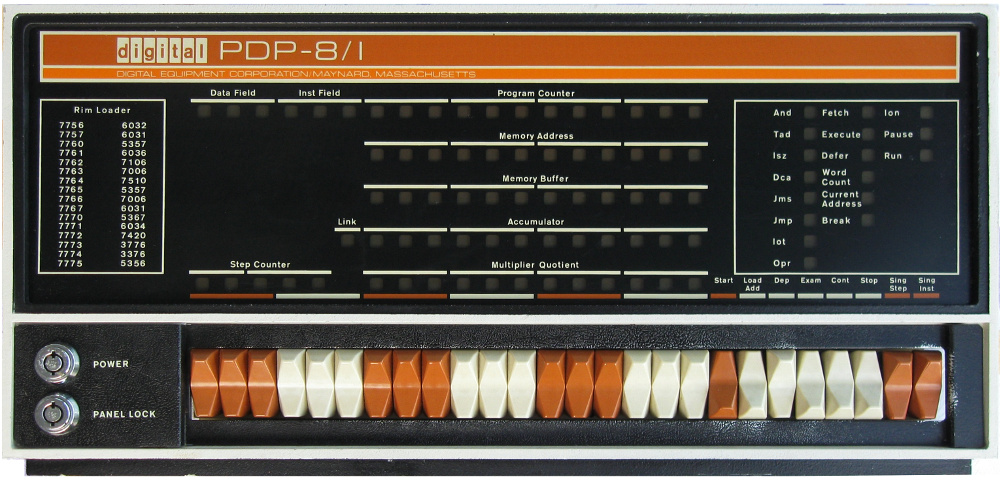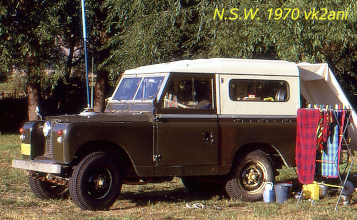Why PDP8? - A short and abridged personal PDP8 history
During my work I was confronted with process-minicomputers and needed to learn more. So in 1978 I bought an unused PDP8/L with a non-DEC papertape reader, some MainDECs and "Introduction to programming". The learning curve was a bit too steep however so I took the opportunity to obtain two decommissioned PDP8/S chassis to get hands-on experience. As a terminal and a papertape system were needed I built a → Heathkit H9 Terminal and H10 Reader/Punch to load MainDECs and software (the picture shows my VCFE display from 2018). Later I designed and built an interface to drive a → Siemens T-100 teletype as a printer - including the ASCII to Baudot converter using plenty of diodes! This system around a → PDP8/S (the link shows my former machine in the museum) with 4k memory and running a line editor was my first personal computer!
Once bitten by the bug the next steps had to follow: the → PDP8/L with a BM/8 box with memory extension to 12k using 8/E boards was added and
made operational. Now the remaining problem was mass storage to be able to run OS/8. Two → DF32 disks were
obtained but I failed to make them really work. Then I got a rack and a → TU56 dual
DECtape drive with a TC08 controller and now OS/8 could be loaded and generated from papertapes. Success!
Around the same time I got a decomissioned (see picture below) PDP8/I and was able
to buy second-hand memory extensions and a second machine to allow me to install 24k and all kinds of options the 8/I was prewired for. Complete with another DEC rack this began to become
quite a powerful machine and the 8/L was retired. See here a → gallery of my PDP8/I system - now also in the museum at
Stuttgart.

My former spare PDP8/I Front Panel
The → PDP8/E - being the more modern machine - was added in a new rack with a → dual RX01 diskette drive brought back from the US. A second TU56 for the 8/E and later a RX01 for the 8/I [→ the interface I designed is here] added so software and data could be moved between machines. Needless to say that a LA34 printer and → VT52/VT100 terminals replaced the Heathkit H9 and the Siemens T100 teletype. Eventually a → RK05 disk drive was added and now I really had a fast computer system. Which did not prevent me to get hold of two decommissioned PDP8/A systems with two RL02 disk drives. This machine was then placed in the rack where the 8/E was and now the → 8/A + 8/I system looked quite powerful! To improve printed output from VISTA and RUNOFF an old punch interface was converted to → parallel printer output and a OS/8 driver written to print on an EPSON 850 including bold and italic letters.
Since then the 8/S, 8/L and two 8/Es were sold, the RK05 and other stuff given away. The 8/A - now also gone - remained working but the 8/I stood just there looking nice. Then this 8/I machine had, supported by all spare parts I had, a much brighter future as a working display at the → Stuttgart computer museum!
Here in my lab a → 8/E "breadboard" has been built as "replacement" using 8/E spare boards and another RX01. This makes use of some modern improvements: switching power supplies, Vince Slyngstad's solid state → 32kW memory board, Bob Armstrong's → VT6 interface to go into the local KVM-switch, the parallel printer output etc. OS/8 runs nicely with the RX01 but is quite slow of course - maybe Kyle Owen's → RK05 simulation will improve things?
Tinkering a bit with the 6100 based → Intersil 6960 Sampler board I tried my hand at the microprocessor version of a PDP8. Then as a result I had to build the → SBC6120 and → FP6120 front panel when they came out! Now I had to build the → SBC6120-RBC Edition after this effort got under way.
Some more recent activities involving the breadboard PDP-8E and the SBC6120 were undertaken for VCFE exhibitions and might be worth to look at here → VCFE Exhibition Displays.
